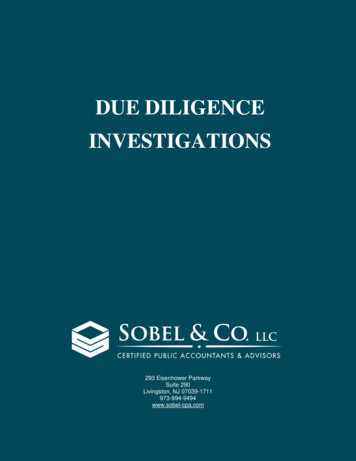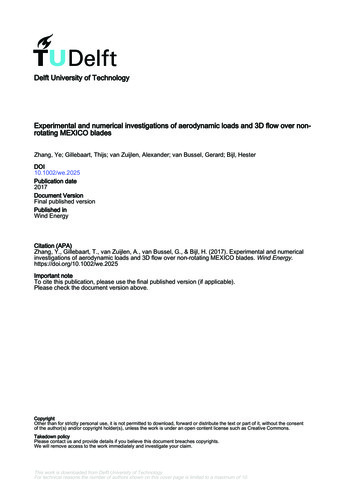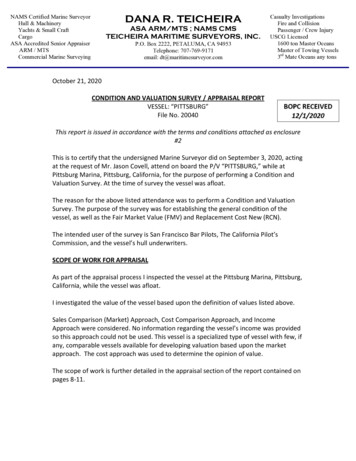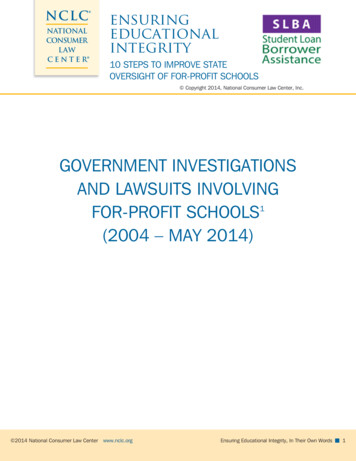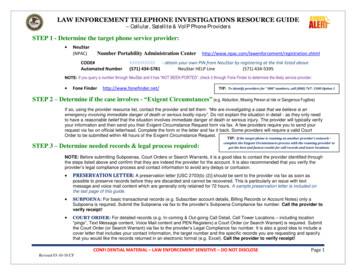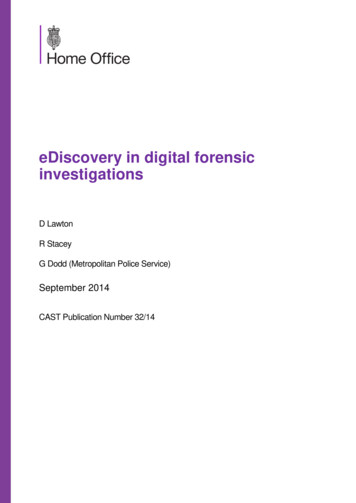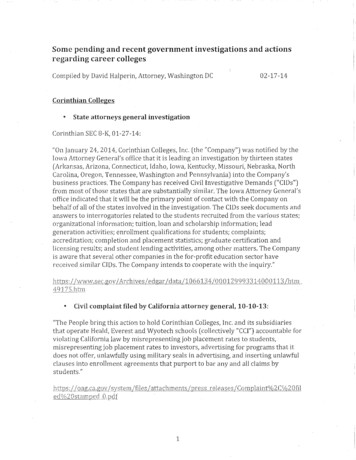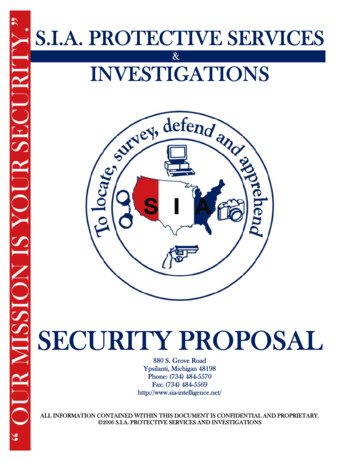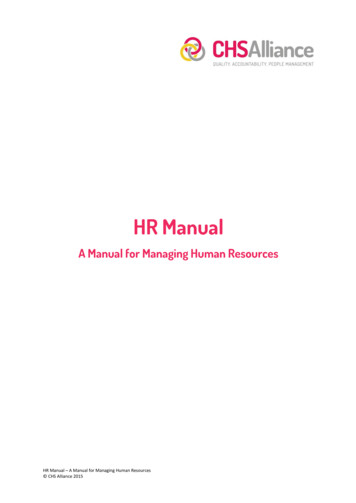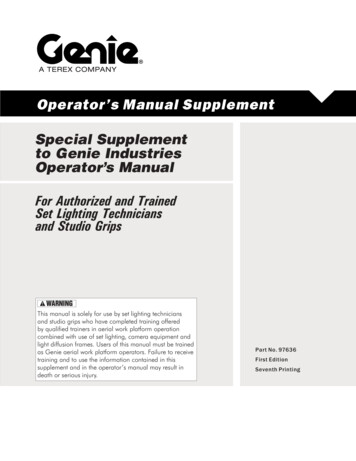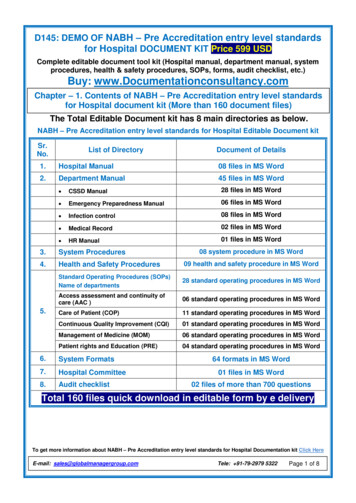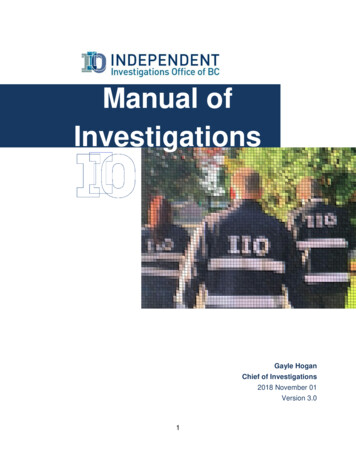
Transcription
Manual ofInvestigationsGayle HoganChief of Investigations2018 November 01Version 3.01
Table of ContentsChapter 1: Introduction .5Chapter 2: IIO Case Management.7Why Do We Utilize IIO Case Management? .7Principles of IIO Case Management .71)The Command Triangle . 72)Communication . 83)Leadership and Teams . 94)Management Considerations . 95)Investigative Strategies.106)Accountability Mechanisms .107)Ethical Considerations .118)Legal Considerations .119)Partnerships .12Chapter 3: Roles and Responsibilities.13Chief Civilian Director .13Chief of Investigations .13Command Triangle .14Team Director .14Primary Investigator .14File Coordinator .15Affiant .15Investigator.16Forensic Investigator .16Investigative Assistants.17Affected Persons Liaison .17Chapter 4: Notification, Deployment and Initial Investigation .20Notification .202
Deployment .20Concurrent Investigations with Police Agencies.20Chapter 5: Investigation Considerations.22Maximize Evidentiary Opportunities .22Critical Thinking .22Risk Management .23Prevention of Tunnel Vision .23File Reviews .24Chapter 6: Investigative Process and Procedure – Note Taking .26Importance of Note Taking .26Note Taking Considerations .26Best Practices for Notebooks .27Daily Notebooks (Daily Logs, General Notebooks) .27Chapter 7: Investigative Process and Procedure - Briefings .28Purpose and Frequency of Briefings .28Preparation for Briefings .28Practical Considerations for Briefings .28Separate Briefings .29Debriefings .29Other Meetings .29Chapter 8: Investigative Process and Procedure - Decision Making .30Decision Making.30Who Should Maintain a Decision Log? .30Why Maintain a Decision Log?.31What Types of Decisions Should be Included? .31What Should Be Documented? .31Considerations for Decision-Making .31Phases of Decision Making .32Investigational Logs .32Chapter 9: Investigative Process and Procedure - Canvassing for Witnesses .343
Purpose of Canvass .34Types of Canvass .34Practical Considerations .34Video Canvassing .35Social Media/Media Canvassing .35Chapter 10: Investigative Process and Procedure - Interviews .36Interviews - General .36Pre-interview Disclosure .36Witness State of Mind .36Affected Persons.37Witness Officers .37Subject Officers.38In-Custody Subject Officers .39Youth and Vulnerable Witnesses .40Sworn Statements (KGB): .40Follow Up & Second Interviews: .40Disclosure Obligations .41Preparation for Disclosure.41Disclosure to Other Agencies.42Holdback Information .43Investigation Notes, Emails and Disclosure Statements .43Disclosure of Police and IIO Disciplinary Records .44APPENDIX 1: NINE PRINCIPLES of IIO CASE MANAGEMENT .45APPENDIX 2: RECOMMENDED READING .474
IIO – MANUAL OF INVESTIGATIONSChapter 1: IntroductionThe Independent Investigations Office of BC (IIO) is mandated to conduct investigationsinto police-related incidents of death or serious harm in order to determine whether or notan officer may have committed an offence. The IIO derives its authority from the BritishColumbia Police Act.Grounded and directed by its mission, vision and values, the IIO strives to be the leadingoversight agency, enhancing the public’s faith in police accountability. IIO Investigatorsmust conduct themselves with professionalism, excellence, collaboration, trust andcourage. Through our people, we achieve investigative excellence and transparentreporting of serious police incidents for British Columbians.The IIO undertakes public interest investigations, conducting them to a criminal lawstandard. There does not need to be an allegation of wrongdoing for the IIO to conduct aninvestigation. The IIO gathers all evidence and reports back on the results. The IIO doesthis in as transparent a manner as practicable in the circumstances, respecting the integrityof the investigation and the privacy interests of those that we deal with.To meet those high standards, the IIO will utilize the best investigative practices availableand be driven by the law. As part of its commitment to that standard, the IIO will apply theprinciples of Major Case Management (MCM) and be open to scrutiny and continuousimprovement.The IIO’s Manual of Investigations (MOI) applies the MCM concepts to oversightinvestigations. The result is an IIO-specific manual of best practices. To accompany theMOI, Standard Operating Procedures (SOPs) have been developed to provide more detailon specific areas. The Business Rules complement the SOPs and can also be applied andadapted to individual investigations. This flow, from broad principles to detailed BusinessRules, promotes understanding of, and adherence to, best practices.A great deal of work and consultation has gone into the development of this MOI. Seniorinvestigators, police, stakeholders and other oversight bodies have all provideddocuments, insight and direction. Many of their concepts and language are openlyreflected or reproduced here.5
IIO – MANUAL OF INVESTIGATIONSIIO VISION, MISSION & VALUESVISIONThe leading oversight agency, enhancing the public’s faith in police accountability.MISSIONThrough our people, we achieve investigative excellence and transparent reporting ofserious police incidents for British ationTrustCourage6
IIO – MANUAL OF INVESTIGATIONSChapter 2: IIO Case ManagementIIO Case Management is utilized to manage all IIO investigations. IIO Case Managementis a reflection of the Major Case Management (MCM) methodology used by police andother provincial investigative bodies for managing major investigations. IIO CaseManagement structures investigations by providing clear goals and objectives,establishing lines of responsibility and decision-making authority, and creatinginfrastructure for the recording, storage and sharing of information.Why Do We Utilize IIO Case Management?In Canada, a number of high profile cases have led to reviews and public inquiries into thepolice handling of serious investigations. Those reviews, and the lessons learned fromthem, have ultimately resulted in the formalization of the MCM model.The same principles and disciplines of MCM provide the framework for IIO CaseManagement. The IIO Case Management builds an investigative structure based on bestpractices in order to fulfill our mandate. The British Columbia Provincial Policing Standardsmake MCM mandatory for the IIO in all major cases (beginning January 2019).Significant insight into the development of MCM in Canada and its strengths can be seenin the following reviews and inquiries: The Royal Commission on the Donald Marshall Jr. Prosecution (1989)The Bernardo Investigation Review (Mr. Justice Archie Campbell - 1996)The Commission on Proceedings Involving Guy Paul Morin (1998)Mindy Tran, Homicide of, Administrative Review (Insp. R.G. Ambler - 2000)The Inquiry Regarding Thomas Sophonow (2001)Commission of Inquiry into the Wrongful Conviction of David Milgaard (2005)The Missing
IIO Case Management is utilized to manage all IIO investigations. IIO Case Management is a reflection of the Major Case anagement (MCM)M methodology used by police and other provincial investigative bodies for managing major inIIO Case vestigations. Management structures investigations by providing clear goals and objectives, establishing lines of responsibility and decisionmaking authority .
